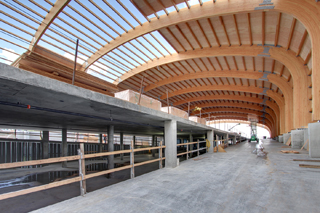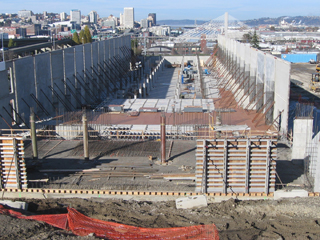|
Subscribe / Renew |
|
|
Contact Us |
|
| ► Subscribe to our Free Weekly Newsletter | |
| home | Welcome, sign in or click here to subscribe. | login |
Construction
| |
 |
May 31, 2012
LeMay structure: function with flair
Magnusson Klemencic Associates

Briggs
|
The design of America’s Car Museum was a decade in production.
The museum you see today is the result of continual shaping and test-driving of the design — sometimes like a speed run on the autobahn, sometimes like slamming on the brakes and pulling a U-turn. Magnusson Klemencic Associates was along for the ride, providing structural and civil engineering design throughout the project’s many twists and turns.
False starts
The original master plan by Grant Price Architects envisioned the museum as an anchor for the area around the Tacoma Dome, revving up the neighborhood with a new destination attraction and adding new retail and movie theaters.
The plan was to develop the museum in phases, starting with the centerpiece, an aerodynamically shaped glass exhibit pavilion spanning the length of a football field. The next phase would add a “car collection center” to store and exhibit up to 350 vehicles, and a large outdoor grass field for car shows and other events.
Unfortunately, the vision was as grand as the price tag, and with the economy in decline the owners reassessed the timing and their priorities. Ultimately, the car collection center and show field portions took pole position, overtaking the exhibit pavilion as lead.
The master plan for the car collection center included a below-grade storage space beneath the 3.5-acre show field, creating a museum with one level above grade and the other below. However, the cost of structurally supporting a dirt-and-grass show field on top of storage space, combined with waterproofing issues related to storing valuable cars underground, proved cost prohibitive.
Parking garage design
Back at the drawing board the design team explored combining the storage and exhibit areas in a vertically stacked configuration, with the show field simply placed on grade. This was the design team’s aha! moment: A parking-garage design approach — with vertically stacked ramps connecting to each of the floors — combined the best of all worlds.
The new design for the now four-story car collection center provides a place to safely store LeMay’s collection while creating exhibit space along gently sloping ramps. The ramps, running along both sides of the building, connect the four floors in a racetrack-shaped path.
To provide a slope with a grade gradual enough for visitors to easily walk and admire the collection, the ramps had to extend 276 feet, resulting in an overall building length of 440 feet. This need to stretch the ramps transformed the parking garage configuration from limo to stretch limo.
The dimension of the center area between the ramps was set by the space required to store and move the cars in the collection. The resulting storage and exhibition facility is 440 feet long by 100 feet wide, creating a 165,000-square-foot museum.
Multi-duty pilasters
The structural system was developed with simplicity and costs in mind. The four-story concrete “box” housing the car collection is topped by a heavy timber roof comprising a series of glu-lam arched beams spanning the width of the building. Although simple in concept, the design of the concrete box and roof presented significant structural challenges.
The first challenge was from the museum’s atypical floor layouts. The concrete box is 37 feet tall with 12.5-foot floor-to-floor heights and 23-foot-wide ramps along the building’s perimeter. The location and sloping nature of these ramps creates discontinuous floors in areas, meaning the floor slabs do not span completely from one edge of the building to the other. This results in the exterior of the building being “softer” and more prone to deflection during an earthquake.
To counteract that condition, the design borrowed strength from another required structural element. The large glu-lam roof beams needed support, so large 15-by-60-inch-deep concrete pilasters were located along the building’s perimeter for that purpose. Since these pilasters are vertically continuous from ground to roof, they were also used to connect the discontinuous floors along the ramps, stiffening the building’s perimeter.
But these pilasters did even more work. The contractor, JTM, asked the design team if they could design for a tilt-wall type of construction to speed erection and reduce finish costs. They wanted to cast the 37-foot-tall concrete walls horizontally on the slab-on-grade, using a form liner to create a finished architectural exterior surface, and then lift the walls into place.
MKA designed the walls to accommodate the contractor’s erection request and used the concrete pilasters as a means of connecting the individual tilt-wall panels. So this structural design not only created the concrete box that supports the roof, it also resulted in a series of niches between the deep concrete pilasters that the museum uses for displays along the sloping ramps.
Arch support
Viewed from Interstate 5, the museum’s roof structure is a car-inspired body sitting atop a parking garage-inspired concrete chassis. While the metal-clad exterior is impressive, what’s under (and supporting) the hood is just as unique.
Initial roof concepts ranged from a lattice-inspired steel-and-wood structure with a translucent skin to a system of repetitive steel bent frames and skylights inspired by old-style European rail stations. Ultimately wood was selected due both to its structural properties and the architect’s vision.
The glu-lam roof arches are 52.5 inches deep and 8.75 inches wide spaced at 23 feet along the building’s length. The vertical “legs” of the glu-lams vary in height along the length of the building to create the roof shape without changing the radius of the arches themselves.
This repetitive-arch design simplified construction and helped reduce costs. Unique from a structural perspective, the glu-lam arches were designed to not only carry the weight of the roof and snow loads, but also serve as lateral frames to resist wind and earthquake forces. This application of heavy timber design blends nicely with the museum’s timber-domed neighbor next door.
Greg S. Briggs is a principal at MKA and leader of the firm’s Museum Specialist Group. His dream car is a 2006 Ford Tungsten GT Limited Edition.
Other Stories:
- Cadillac project on a Model T budget
- 4 must-haves for a successful civic project
- HVAC system keeps LeMay breathing easy




